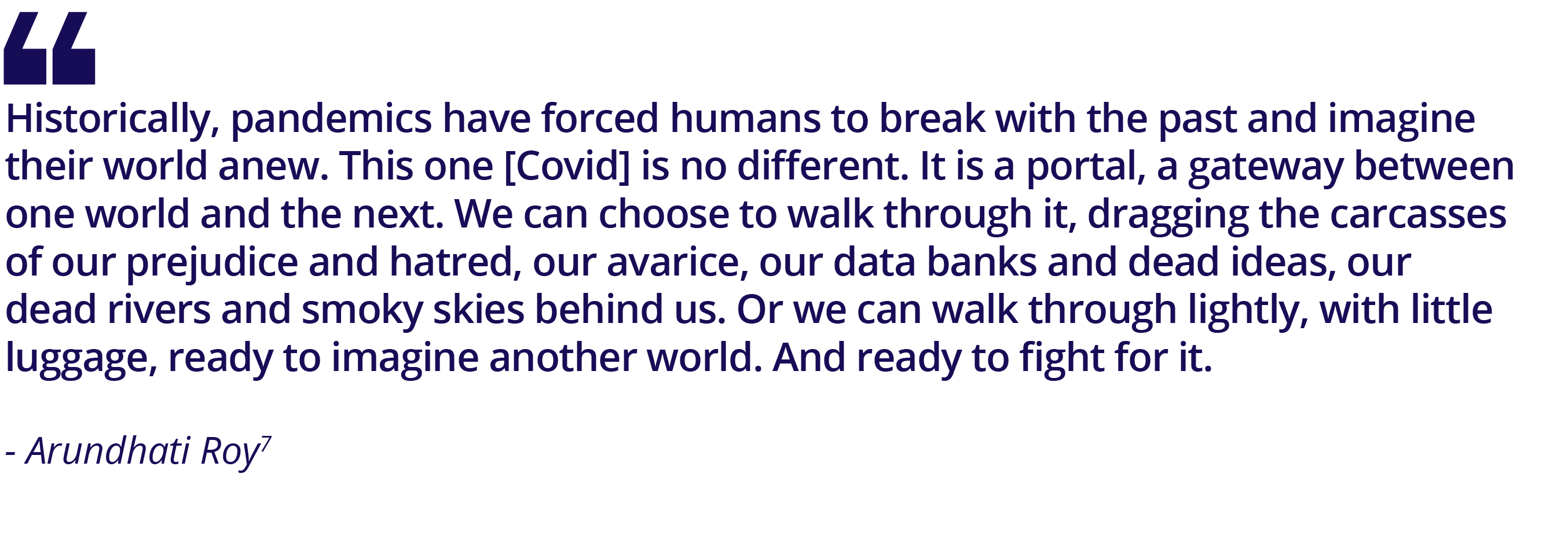Theme 2: Imagining the Future We Want

What is the world we want to bring into being? Let’s imagine a world without systemic inequities, injustices, and violence. Let’s name the values and ways of being that will take us there. What is our vision? These are not frivolous questions. If we take our vision seriously, it becomes a guiding star, helping us discern and make strategic choices that move us closer to the deeper change we seek. A visioning process can embolden us to ask more fundamental questions about the conditions in which we are living and why things are the way they are. Activating our radical imagination can open up a sense of possibility and invite more interesting proposals that upend power and go beyond conventional statements of vision and mission.
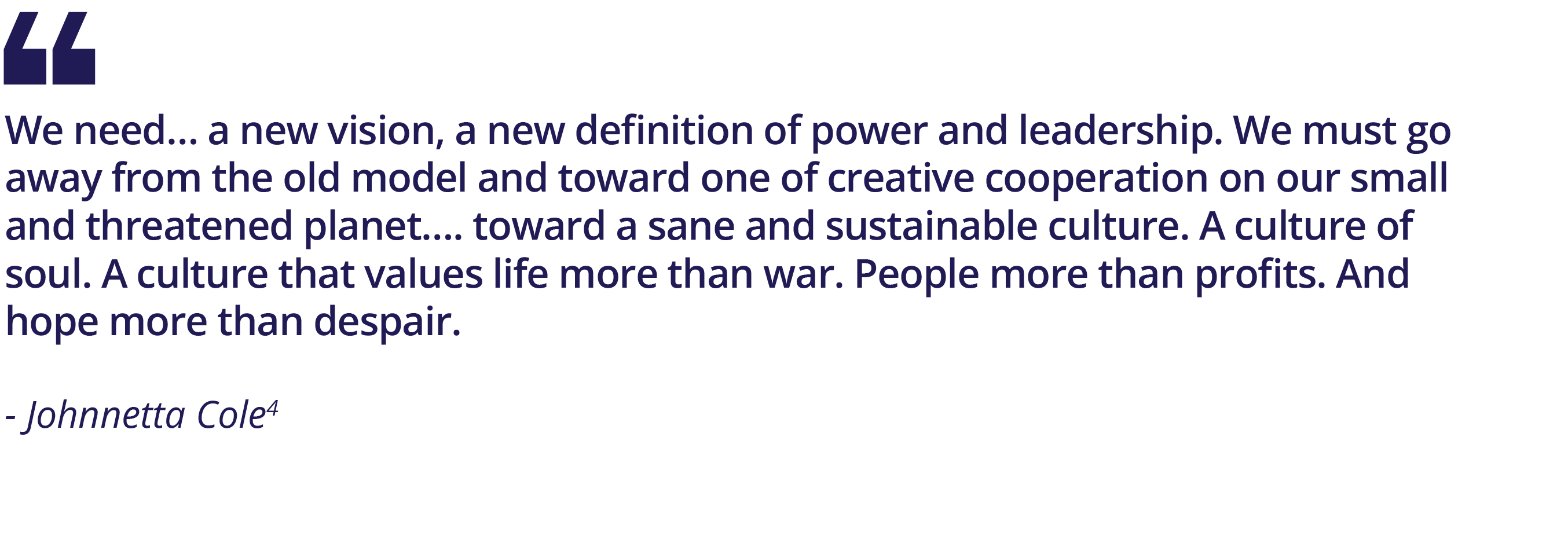
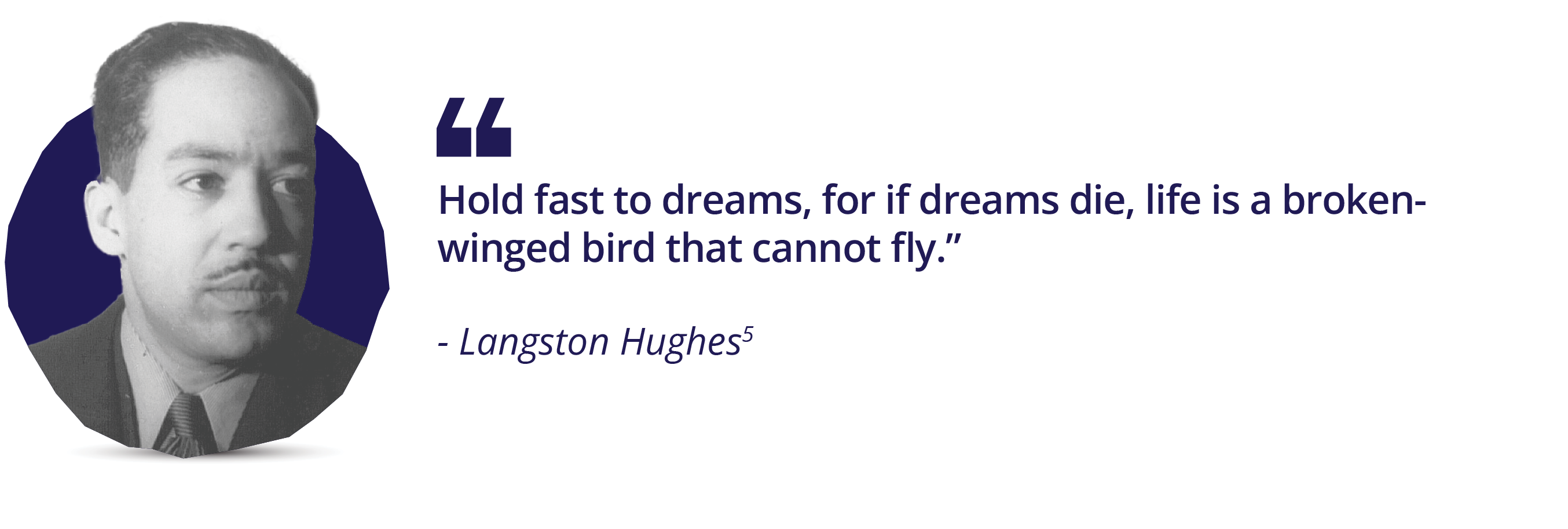

Activity 3: Dreaming the Future
Activity 3: Dreaming the Future
Any process to spark new ways of seeing, thinking, and acting needs to take us beyond our usual thought processes to touch our emotions, beliefs, longings, and dreams. These drew us to this work in the first place and will animate new thinking, approaches, and ever stronger relationships. Here we explore our dreams and collective visions for the future.
Materials: Flip charts, post-its or cards of four different colours, markers, tape, letter-size paper, different coloured paper and tissue paper, written instructions, and relevant quotes.
Plenary: Read the quotes aloud to draw people from day-to-day thinking into a mode of imagining. While some were written in particular moments such as the beginning of the COVID pandemic, they speak to any crisis that triggers the necessity of rethinking and imagining other ways of being. Feel free to use quotes from your context to invite reflections on dreams of a better future.
Our dreams have been important in inspiring change and sustaining hope and community. The simple process of envisioning a better future is a critical action in itself. As we confront the violent systems around us:
- What do we centre in our work?
- How do we shape our vision and stay true to our values?
- What stars guide us along the way to making our dreams a reality?
Step 1: Dreaming
Individually: In order to invite a creative mindset, take a walk outdoors and really pay attention to what you see, smell, and hear; or listen to music or sing; or choose another activity that takes you out of the strictly rational brain. Allow yourself to visualize your desired future.
- What is the future you dream about?
- Where are you? Who are you with?
- What are you and people around you doing?
- What is the environment like? What do you see? What colours? What sounds? What smells?
- How are you feeling?
In two to three words, fill the gaps on colour-coded post-its, one colour per phrase:
I have a dream of a future where everyone will__________ (colour 1), where no one will_______ (colour 2), and where the land and environment will _________ (colour 3). One idea or belief that feeds my dream and my work toward it is _________ (colour 4).
Using markers, pencils, coloured crayons, and/or collage, create a “quilt square” – an image on letter-size paper (of different colours, if possible) – to represent the future you have imagined.
Plenary: Each person shares their image, and these are placed one-by-one together on a wall, floor, or table to make a quilt. In turn, each person reads their colour-coded dream statements and idea or belief. As they read, group the statements on a wall into similar themes and open a short discussion.
- What do these different images and cards say to us about our visions for the future?
- What are the ways we want our lives and the world to change?
- Do you see common sources of hope? How can we use these sources of hope and possibility in our organizing and change-making work?
- What brings us together? What are some of the differences?
- What do they say about our guiding values and purpose, what we stand for?
- What do they say about our hearts and feelings?
Step 2: Reimagined futures
Our individual dreams inspire us and others but to make change we must pool our dreams and collectively reimagine the future. Imagine that you’ve teleported to 2060, a time when a better world has arrived.
Options that might invite inspiration:
- Watch the video: Message from the Future
- Read selections from In a Time Not So Far Away
- Watch a video from the Movement for Black Lives: Black Futures – Ode to Freedom Summer
Alternatively, find examples in other languages or from other contexts.
Small groups: To show a radically reimagined world, create a five-minute role play, make a short video on a phone, or describe four scenarios that allow others to see what you see.
- What do we see?
- How do we feel?
- What are people doing differently? For economic well-being? For political and social problem-solving?
- How are communities organised?
- How do people relate to their environment?
Plenary: Each group presents their vision of the future. Discuss the futures you imagine. How do they connect to your dreams from Step 1?
Step 3: How will we get there?
Plenary: Re-read the Arundhati Roy quote. Repeat the last phrase: “We can walk through lightly, with little luggage, ready to imagine another world. And ready to fight for it”.
Display a new flip chart or screen entitled “Travelling to the Reimagined Future” with two columns headed “In order to get to this vision, what will I take? and what will I leave behind?”
Individually: Write two or three post-its in answer to each question and post them in the columns.
Plenary: Invite people to share what they posted and discuss what we’re leaving behind and what we’re taking with us. What do we learn about our visions looking at these lists?
Step 4: Values, principles, and ways of working
Building on the previous discussion, identify the core values, principles, and ways of working – both individual and collective – that will guide us toward our imagined future.
Individually: On two stickies, write:
One important value or principle that will be essential for living our visions.
One way of working or leading, or one practice that must change to enable us to realise these values.
Plenary: Cluster responses and invite discussion.
- What do we find in common?
- Are there any notable differences?
Summarise the discussion and read out the quotes from Johnetta Cole and Langston Hughes (see Theme 2).
Download this activity.
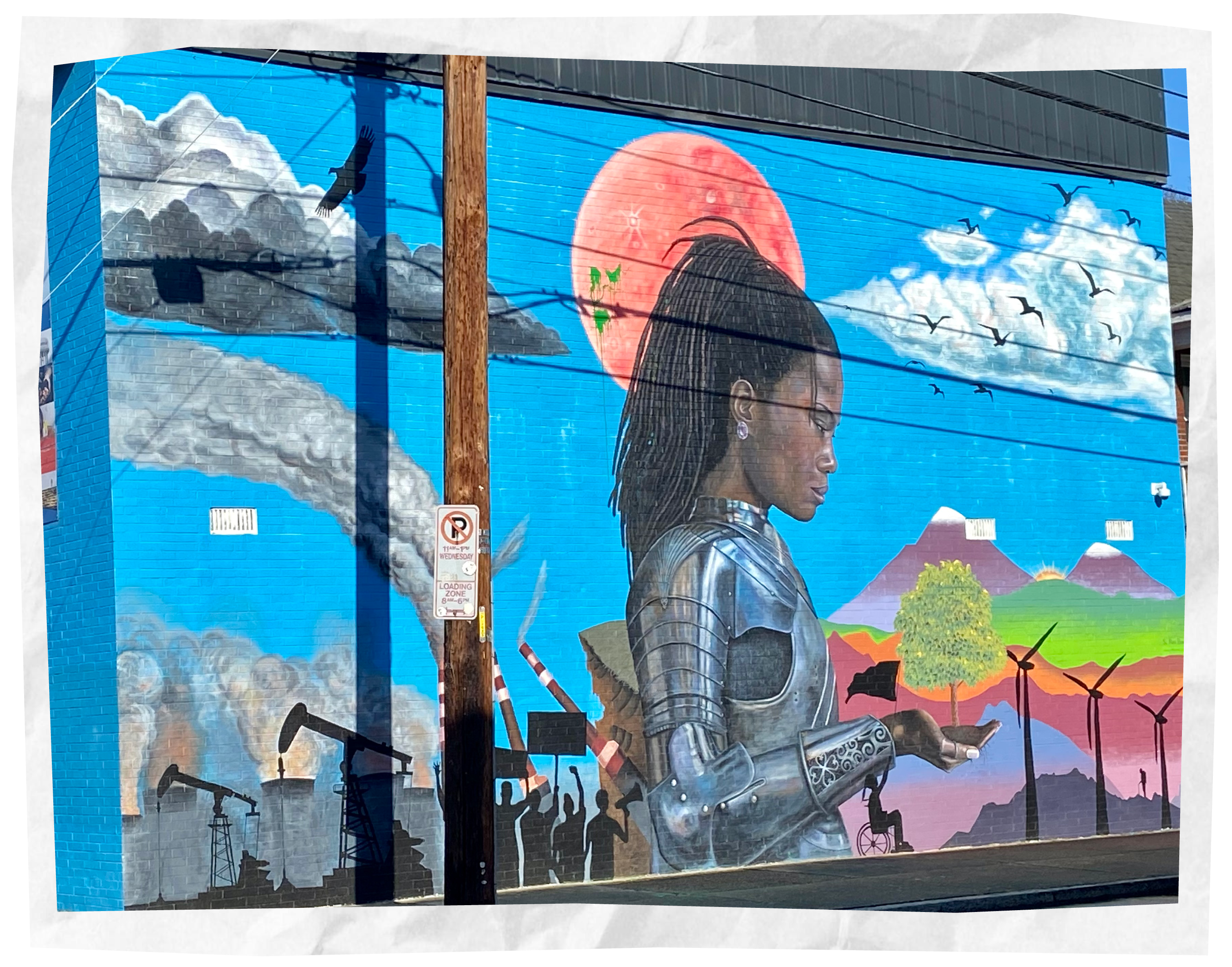
Activity 4: Bringing visions to life
Activity 4: Bringing visions to life
Step 1: Visions for social change that can inspire us
If our vision feels stale or too limited, or if we don’t have one, we can gain inspiration from looking at those of others. You may want to explore a selection of bold visions from Visions and values in action (below).
Plenary: Use these examples or brainstorm examples of other organisations or movements – past or present – whose vision, values, and ways of working inspire you. Ask:
- What is appealing about how they lay out their vision and how they live their values in their activism and leadership?
- What are some of the challenges of putting values and principles into practice?
Step 2: Bringing visions to life
Here, we contrast the what and the how to judge how our values, principles, and ways of working align with our vision. Use Option 1 if people are all from the same organization, or if they can be grouped by organization. Use Option 2 if people are mostly from different organisations or as a follow-up to Option 1.
Option 1: Same organisations
Small groups: What is your organisation’s vision? This may be an existing vision statement, or you may need to take some time as a group to write down the vision as you all understand it.
- How do you feel about your organisation’s vision?
- Could the vision be improved or stretched? If yes, what would you change?
- Does the vision reflect the values, principles, and ways of working you identified?
- If yes, how?
- If not, how could your values, principles, and ways of working bring the vision to life? Or how could the vision be changed to better reflect your values and ways of working?
Pick three insights to share in plenary.
Plenary: Groups share insights.
- What does this tell us about the connection between our visions and our ways of working?
- What needs to change to align our practices with our visions?
- Where do we need to stretch or challenge ourselves?
- Is it about the what or the how or both?
The purpose of this discussion is not to find answers, right or wrong, or to decide now what needs to change, but to stimulate thinking. Remind people that they will return to these questions later, enriched with other perspectives.
You could go back to the inspiring organisations or movements named in Step 1. How did they align their what with their how?
Option 2: different organisations
Go back to the inspiring organisations or movements named in Step 1, or name examples familiar to the group, or draw on the handout Visions and values in action. Each small group discusses a different organization or movement.
Small groups: For the organisation or movement you are looking at:
- What is the vision? Find their vision statement or describe your understanding of it.
- How do you feel about this vision?
- What do you think are or were their core values, principles, and ways of working?
- Does the vision reflect these values, principles, and ways of working?
- If yes, how?
- If not, what values, principles, and ways of working could help bring the vision to life? Or how could the vision be changed to better embody values, principles, and ways of working?
Pick a reporter and three insights to share in plenary.
Plenary: Groups share insights.
- How does looking at these visions make you feel? What questions or reflections do they surface for you and for your own work?
- What does this tell us about the connection between an organisation or movement’s vision and its ways of working?
- What challenges were involved, if any, in aligning vision with principles, purpose with practice – the what and the how?
Download this activity.
Vision and values in action
What people believe to be valuable guides their actions, whether these values are unspoken and unacknowledged or spelled out clearly. When people express their values and weave them together, they are creating a coherent vision or philosophy. With a shared vision, a movement or collective can advance together.Here are five examples of deeply considered and coherent visions to guide short- and long-term strategies and action. Find, share, and discuss examples from your own context.
Principles of Earth Democracy
Vandana Shiva is described as “an Indian scholar, environmental activist, food sovereignty advocate, ecofeminist, and anti-globalization author”. This set of principles, summarised from her books, presents an overall philosophy and vision as a rich basis for activism.8
- Ecological democracy – democracy of all life
We are all members of the Earth community. We all have the duty to protect the rights and welfare of all species and all people. No humans have the right to encroach on the ecological space of other species and other people, or treat them with cruelty and violence.- Intrinsic worth of all species and peoples
All species, humans, and cultures have intrinsic worth. They are subjects, not objects of manipulation or ownership. No humans have the right to own other species, other people, or the knowledge of other cultures through patents and other intellectual property rights.- Diversity in nature and culture
Defending biological and cultural diversity is a duty of all people. Diversity is an end in itself, a value, a source of richness both material and cultural.- Natural rights to sustenance
All members of the Earth Community including all humans have the right to food and water, to safe and clean habitat, to security of ecological space. These rights are natural rights, they are birthrights and are best protected through community rights and commons. They are not given by states or corporations, nor can they be extinguished by state or corporate action, through privatisation or monopoly control.- Earth economy is based on economic democracy and living economy
Earth democracy is based on economic democracy. Economic systems in Earth Democracy protect ecosystems and their integrity, they protect people’s livelihoods and provide basic needs to all. In the earth economy there are no disposable or dispensable species or people. The earth economy is a living economy for the benefit of the common good.- Living economies are built on local economies
Conservation of the earth’s resources and creation of sustainable and satisfying livelihoods is most caringly, creatively, and efficiently and equitably achieved at the local level. Localisation of economics is a social and ecological imperative. Only goods and services that cannot be produced locally, using local resources and local knowledge, should be produced non-locally and traded long distance.- Living democracy
Earth democracy is based on local living democracy with local communities – organised on principles of inclusion and diversity and ecological and social responsibility – as the highest authority on decisions related to the environment and natural resources and to the sustenance and livelihoods of people. Authority is delegated to more distant levels of governance on the principle of subsidiarity. Earth democracy is living democracy.- Living knowledge
Earth democracy is based on earth-centred and community-centred knowledge systems. Living knowledge is knowledge that maintains and renews living processes and contributes to health of the planet and people. It is also living knowledge in that it is embedded in nature and society, is not abstract, reductionist, or anti-life. Living knowledge is a commons, it belongs collectively to communities that create it and keep it alive. All humans have a duty to share knowledge. No person or corporation has a right to enclose, monopolise, patent, or exclusively own as intellectual property living knowledge.- Balancing rights with responsibility
In earth democracy, rights are derived from and balanced with responsibility. Those who bear the consequences of decisions and actions are the decision makers.- Globalizing peace, care, and compassion
Earth democracy connects people in circles of care, cooperation, and compassion instead of dividing them through competition and conflict. Earth democracy globalises compassion, not greed, and peace, not war.The Care Collective
This vision and manifesto circulated widely when ‘care’ emerged as a central political agenda in 2020 during the Covid pandemic. This short version gives a sense of the principles and practice at its core.9
- Interdependence: To imagine a world organised around care, we must begin by recognising the myriad ways in which our survival is always contingent on others. A caring politics must first and foremost acknowledge our interdependence alongside the ambivalence and anxiety these connections routinely generate. Recognising our needs both to give and receive care not only provides us with a sense of our common humanity, but also enables us to confront our shared fears of human frailty rather than project them onto others.
- Caring kinships: The traditional nuclear family with the mother at its centre still provides the dominant prototype for care and kinship… Yet it is only by proliferating our circles of care – in the first instance by expanding our notion of kinship – that we can achieve the psychic infrastructures necessary for building a caring society that has universal care as its foundation. Diverse forms of care between all human and non-human creatures need to be recognised and valued. This is what we call ‘an ethics of promiscuous care’. Promiscuous care means caring more and in ways that remain experimental and extensive by current standards. It means multiplying who we care for and how.
- Caring communities: Questions of care are not just bound up with the intimacy of very close relationships. They are also shaped in the localities we inhabit and move through: in local communities, neighbourhoods, libraries, schools, and parks, in our social networks, and our group belongings. But the deliberate rolling back of public welfare provision [where this exists at all], replaced by global corporate commodity chains, have generated profoundly unhealthy community contexts for care.
Communities that care stop the hoarding of resources by the few. Instead, caring communities need to prioritise the commons. Communities based on care ensure the creation of collective public spaces as well as objects: they encourage a sharing infrastructure. This means reversing the compulsion of neoliberalism to privatise everything.
Seven Principles of Zapatismo
This example comes from a resistance movement in Chiapas state in Mexico in 1994 and draws on the deeper history of the ancestors to guide community-building.10The group primarily consisted of Indigenous tribes with their own customs including Ch’ol, Tzeltal, Tzotzil, Tojolobal, Mam, and Zoque. The event made headlines worldwide and sparked a movement for Indigenous rights, autonomy, and social change. The Zapatista Revolution’s uprising, which occurred on the day the North American Free Trade Agreement (NAFTA) went into effect. Zapatistas, as they are commonly known, emerged from decades of organizing among Indigenous peoples to address the systemic issues of poverty, discrimination, and lack of representation faced by Indigenous communities in Mexico.
The Zapatistas’ uprising was a call to action for marginalized communities worldwide and continues to inspire movements for Indigenous rights and social change. Since 1994, the Zapatistas have focused on building autonomous communities that are centred around their Indigenous traditions while seeking to create ‘Un Mundo Donde Quepan Muchos Mundos’ (‘A World Where Many Worlds Fit’), emphasising the dignity of ‘others,’ belonging, and common struggle, as well as the importance of laughter, dancing, and nourishing children.
- Obedecer y No Mandar (to obey, not command)
Execute the will of the people, while holding a position of leadership. In Zapatista autonomous communities, leadership positions are short-lived. This reflects the need for leaders to obey the collective desires of the community rather than command them from a position of power.- Proponer y No Imponer (to propose, not impose)
Humility is a key part of life for the Zapatistas and aligns with their practice of debate and self-reflection, and a culture of proposing a path forward and not imposing one.- Representar y No Suplantar (to represent, not supplant)
Before the coloniser arrived, Indigenous people governed themselves. Self-governance for the Zapatistas, grounded in the collective trust of the community to represent what the community wants.- Convencer y No Vencer (to convince, not conquer)
Zapatistas practise dialogue and assembly, which require logical argument, reflection, consideration of many viewpoints, and open discussion.- Construir y No Destruir (to construct, not destroy)
The ethic of anti-destruction and an end to exploitation is a practice in creating the institutions and the world that we want, in relationship to humans and the land.- Servir y No Servirse (to serve others, not serve oneself)
The Zapatista slogan, ‘Para todos todo, para nosotros nada’ (Everything for Everyone, Nothing for Ourselves), is at the core of this principle of humility. Every Zapatista must find a balance in serving others for the collective while taking care of their individual family work.- Bajar y No Subir (to work from below, not seek to rise)
In Zapatista communities, ‘trabajo colectivo’ (collective work) is a way of life. This aligns with the mentality of working at the grassroots level for the benefit of your community.Climate Justice Charter Movement
This is a South African alliance of progressive civil society, faith communities, labour movements, environmental/climate justice and water sectors, formed to encourage a re-alignment of climate justice forces.11 Their principles and “systemic alternatives for transformative change” define the future they see and how they hope to get there. Their charter provides a guide to specific short-term demands and tactics as well as narratives and long-term strategy. Below are some excerpts.Principles for deep just transitions
Every community, village, town, city, and workplace must advance the deep just transition to ensure socio-ecological transformation. The following principles shall guide the alternatives, plans, and processes towards a deep just transition in our society.
- Climate justice: Those least responsible must not be harmed or carry the cost of climate impacts. Hence the needs of workers, the poor, the landless, people with disabilities, grassroots women, children, and vulnerable communities have to be at the centre of the deep just transition. The benefits of socio-ecological transformation must be shared equally.
- Social justice: Climate justice is social justice. Confront all forms of discrimination and oppression as it relates to race, class, gender, sex, and age, to secure climate and social justice.
- Eco-centric living: Live simply, slowly, and consciously, in an eco-centric way, which recognises the sanctity of all life forms and our inter-connections and enables an ethics of respect and care.
- Participatory democracy: All climate and deep just transition policies must be informed by the voices, consent, and needs of all people, especially those facing harm.
- Socialised ownership: In workplaces and communities, people’s power must express itself through democratic control and ownership, including through democratic public utilities, cooperatives, commoning, communal ownership, and participatory planning, including participatory budgeting in towns and cities to ensure collective management of the life enabling commons and systems.
- International solidarity: Everyone’s struggle is a shared struggle to sustain life. In the context of worsening climate shocks, international solidarity is central to the deep just transition as it serves to unite all who are struggling for emancipation and for a post carbon world.
- Decoloniality: Colonial, neo-colonial, and imperial domination are driving us towards extinction. This is based on the worship of extractivism, technology, finance, violence, and markets. We will actively delink from this system as we affirm an emancipatory relationship between humans and with non-human nature rooted in our history, culture, knowledge, and the wider struggle of the oppressed on planet earth.
- Intergenerational justice: Care for our planetary commons and ecosystems is crucial for intergenerational justice and to secure a future for our children, youth, and those not yet born.
Download handout: Visions and values in action
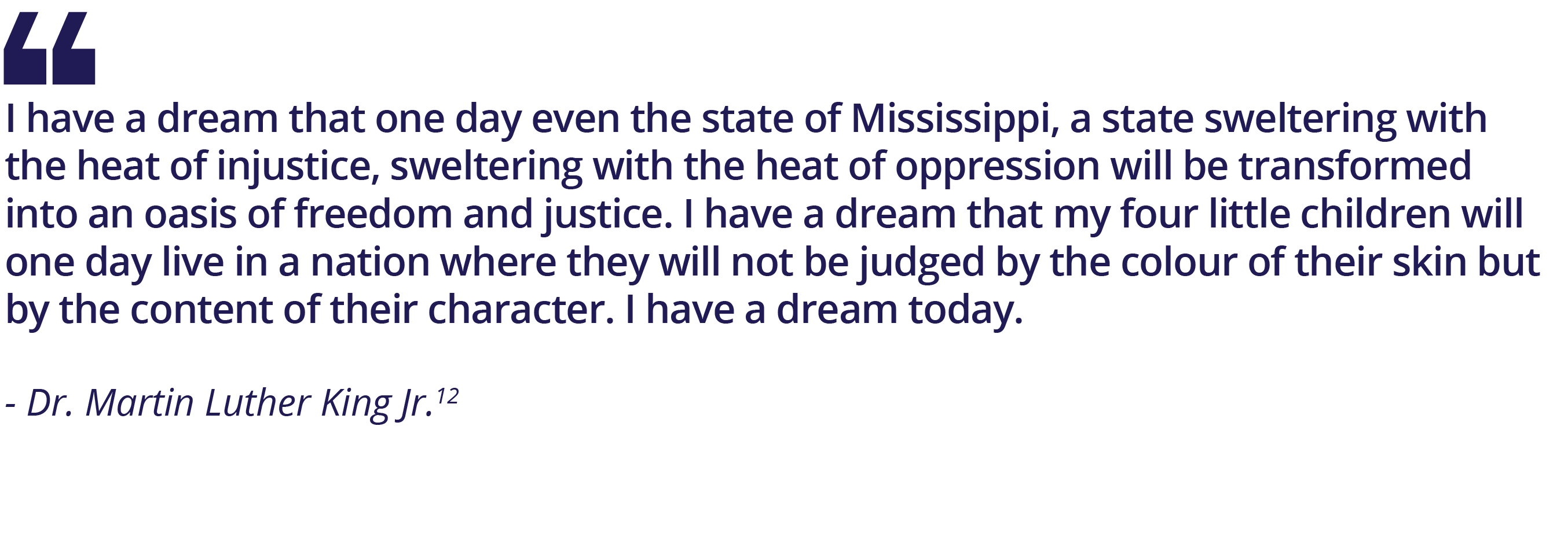
____________________________
3 Uruguayan poet, philosopher, and activist. “In Dare to Question: A journal for uprising”
4 American anthropologist, educator, museum director, and college president.
5 “Dreams”. From The Collected Poems of Langston Hughes, published by Alfred A. Knopf/Vintage. Copyright © 1994 by the Estate of Langston Hughes.
6 African American writer, educator, and spoken word artist.
7 “The Pandemic as Portal”. Financial Times, April 3, 2020.
8 https://systemicalternatives.org/2014/11/25/earth-democracy-ten-principles-of-justice-sustainability-and-peace/ . Vandana Shiva is described as “an Indian scholar, environmental activist, food sovereignty advocate, ecofeminist, and anti-globalization author”. This set of principles, summarised from her books, presents an overall philosophy and vision as a rich basis for activism.
9 Paraphrased from https://www.uhn.ca/Research/Research_Institutes/The_Institute_for_Education_Research/Events/Documents/Care-Manifesto-Readings.pdf. This vision and manifesto circulated widely when ‘care’ emerged as a central political agenda in 2020 during the Covid pandemic. This short version gives a sense of the principles and practice at its core.
10 https://www.themixedspace.com/7-principles-of-zapatismo-to-consider-in-community-building/. This example comes from a resistance movement in Chiapas state in Mexico in 1994 and draws on the deeper history of the ancestors to guide community-building.
11 https://cjcm.org.za/about. This is a South African alliance of progressive civil society, faith communities, labour movements, environmental/climate justice and water sectors, formed to encourage a re-alignment of climate justice forces.
12 US Civil rights activist. Speech in the marble steps, Lincoln Memorial, Washington DC (August 28, 1963)
